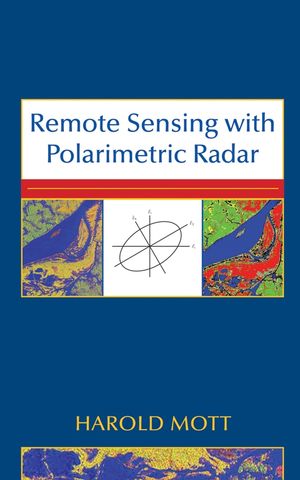Remote Sensing with Polarimetric RadarISBN: 978-0-470-07476-3
Hardcover
328 pages
January 2007, Wiley-IEEE Press
 This is a Print-on-Demand title. It will be printed specifically to fill your order. Please allow an additional 15-20 days delivery time. The book is not returnable.
|
||||||
ACKNOWLEDGMENTS.
1. ELECTROMAGNETIC WAVES.
1.1. The Time-Invariant Maxwell Equations.
1.2. The Electromagnetic Traveling Wave.
1.3. Power Density.
1.4. The Polarization Ellipse.
1.5. Polarization Vector and Polarization Ratio.
1.6. Circular Wave Components.
1.7. Change of Polarization Basis.
1.8. Ellipse Characteristics in Terms of P and Q.
1.9. Coherency and Stokes Vectors.
1.10. The Poincar´e Sphere.
References.
Problems.
2. ANTENNAS.
2.1. Elements of the Antenna System.
2.2. The Vector Potentials.
2.3. Solutions for the Vector Potentials.
2.4. Far-Zone Fields.
2.5. Radiation Pattern.
2.6. Gain and Directivity.
2.7. The Receiving Antenna.
2.8. Transmission Between Antennas.
2.9. Antenna Arrays.
2.10. Effective Length of an Antenna.
2.11. Reception of Completely Polarized Waves.
2.12. Gain, Effective Area, and Radiation Resistance.
2.13. Maximum Received Power.
2.14. Polarization Efficiency.
2.15. The Modified Friis Transmission Equation.
2.16. Alignment of Antennas.
References.
Problems.
3. COHERENTLY SCATTERING TARGETS.
3.1. Radar Targets.
3.2. The Jones Matrix.
3.3. The Sinclair Matrix.
3.4. Matrices With Relative Phase.
3.5. FSA–BSA Conventions.
3.6. Relationship Between Jones and Sinclair Matrices.
3.7. Scattering with Circular Wave Components.
3.8. Backscattering.
3.9. Polarization Ratio of the Scattered Wave.
3.10. Change of Polarization Basis: The Scattering Matrix.
3.11. Polarizations for Maximum and Minimum Power.
3.12. The Polarization Fork.
3.13. Nonaligned Coordinate Systems.
3.14. Determination of Scattering Parameters.
References.
Problems.
4. AN INTRODUCTION TO RADAR.
4.1. Pulse Radar.
4.2. CW Radar.
4.3. Directional Properties of Radar Measurements.
4.4. Resolution.
4.5. Imaging Radar.
4.6. The Traditional Radar Equation.
4.7. The Polarimetric Radar Equation.
4.8. A Polarimetric Radar.
4.9. Noise.
References.
Problems.
5. SYNTHETIC APERTURE RADAR.
5.1. Creating a Terrain Map.
5.2. Range Resolution.
5.3. Azimuth Resolution.
5.4. Geometric Factors.
5.5. Polarimetric SAR.
5.6. SAR Errors.
5.7. Height Measurement.
5.8. Polarimetric Interferometry.
5.9. Phase Unwrapping.
References.
Problems.
6. PARTIALLY POLARIZED WAVES.
6.1. Representation of the Fields.
6.2. Representation of Partially Polarized Waves.
6.3. Reception of Partially Polarized Waves.
References.
Problems.
7. SCATTERING BY DEPOLARIZING TARGETS.
7.1. Targets.
7.2. Averaging the Sinclair Matrix.
7.3. The Kronecker-Product Matrices.
7.4. Matrices for a Depolarizing Target: Coherent Measurement.
7.5. Incoherently Measured Target Matrices.
7.6. Matrix Properties and Relationships.
7.7. Modified Matrices.
7.8. Names.
7.9. Additional Target Information.
7.10. Target Covariance and Coherency Matrices.
7.11. A Scattering Matrix with Circular Components.
7.12. The Graves Power Density Matrix.
7.13. Measurement Considerations.
7.14. Degree of Polarization and Polarimetric Entropy.
7.15. Variance of Power.
7.16. Summary of Power Equations and Matrix Relationships.
References.
Problems.
8. OPTIMAL POLARIZATIONS FOR RADAR.
8.1. Antenna Selection Criteria.
8.2. Lagrange Multipliers.
A. COHERENTLY SCATTERING TARGETS.
8.3. Maximum Power.
8.4. Power Contrast: Backscattering.
B. DEPOLARIZING TARGETS.
8.5. Iterative Procedure for Maximizing Power Contrast.
8.6. The Backscattering Covariance Matrix.
8.7. The Bistatic Covariance Matrix.
8.8. Maximizing Power Contrast by Matrix Decomposition.
8.9. Optimization with the Graves Matrix.
References.
Problems.
9. CLASSIFICATION OF TARGETS.
A. CLASSIFICATION CONCEPTS.
9.1. Representation and Classification of Targets.
9.2. Bayes Decision Rule.
9.3. The Neyman-Pearson Decision Rule.
9.4. Bayes Error Bounds.
9.5. Estimation of Parameters from Data.
9.6. Nonparametric Classification.
B. CLASSIFICATION BY MATRIX DECOMPOSITION.
9.7. Coherent Decomposition.
9.8. Decomposition of Power-Type Matrices.
C. REMOVAL OF UNPOLARIZED SCATTERING.
9.9. Decomposition of the D Matrix.
9.10. Polarized Clutter.
9.11. A Similar Decomposition.
9.12. Polarimetric Similarity Classification.
References.
Problems.
APPENDIX A. FADING AND SPECKLE.
Reference.
APPENDIX B. PROBABILITY AND RANDOM PROCESSES.
B.1. Probability.
B.2. Random Variables.
B.3. Random Vectors.
B.4. Probability Density Functions in Remote Sensing.
B.5. Random Processes.
References.
APPENDIX C. THE KENNAUGH MATRIX.
APPENDIX D. BAYES ERROR BOUNDS.
References.
INDEX.



